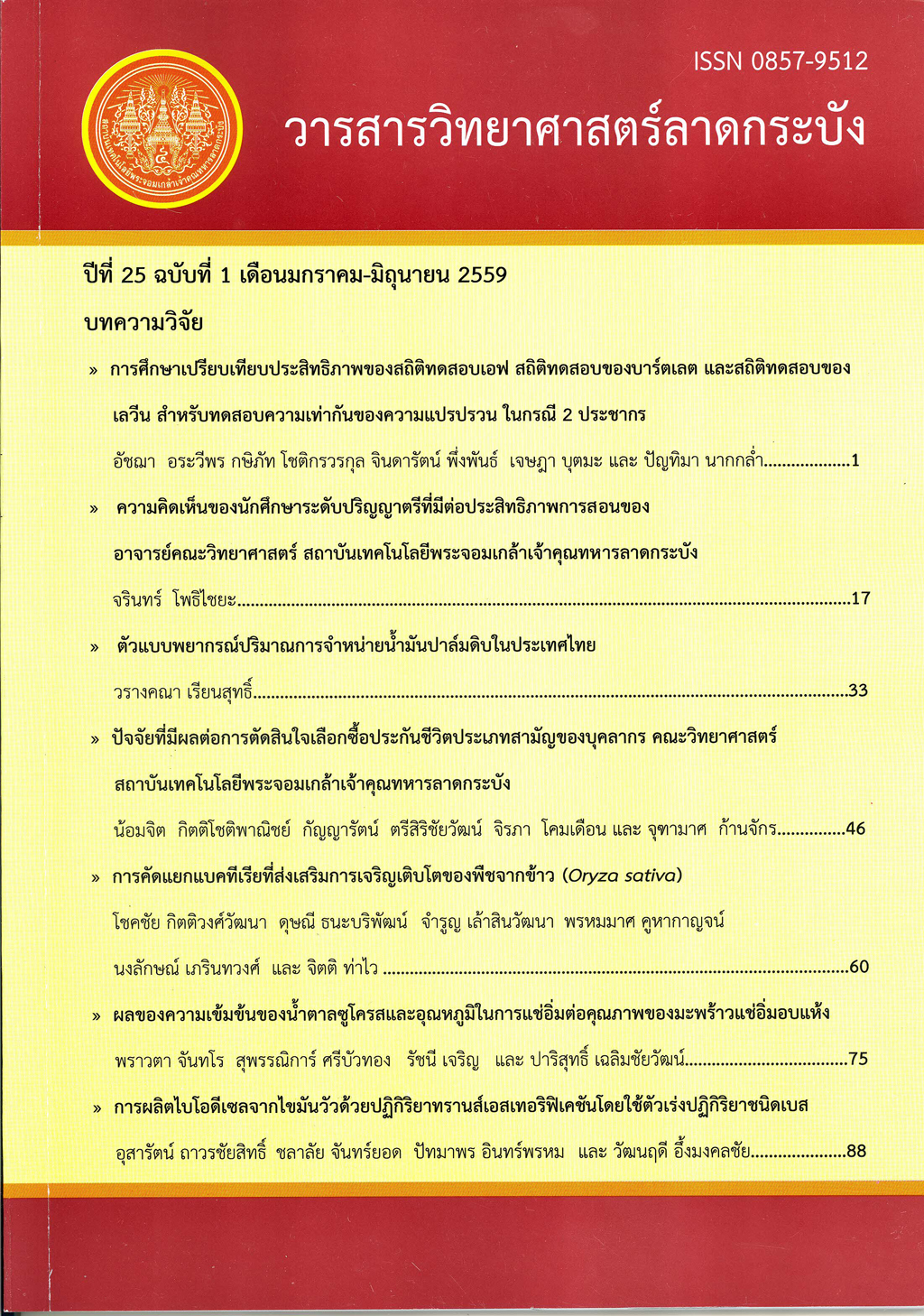การเปรียบเทียบประสิทธิภาพของสถิติทดสอบเอฟ สถิติทดสอบของบาร์ตเลต และสถิติทดสอบของเลวีน สำหรับทดสอบความเท่ากันของ ความแปรปรวน ในกรณี 2 ประชากร โดยใช้โปรแกรมอาร์
Main Article Content
Abstract
บทคัดย่อ
การวิจัยนี้มีวัตถุประสงค์เพื่อศึกษาเปรียบเทียบประสิทธิภาพของตัวสถิติทดสอบเอฟ สถิติทดสอบของบาร์ตเลต และสถิติทดสอบของเลวีน สำหรับทดสอบความเท่ากันของความแปรปรวนในกรณีประชากร 2 กลุ่ม โดยศึกษาจากประชากรที่มีการแจกแจงแบบปกติ (0,9) และแกมมา (9,1) กำหนดขนาดตัวอย่างมีค่าเท่ากับ (5,5) (15,15) (30,30) (5,15) (10,15) (20,25) และ (30,35) กำหนดความแตกต่างของความแปรปรวนของประชากร โดยใช้ค่านอนเซนทรัลลิตี้พารามิเตอร์เป็นเกณฑ์ ดังนี้ 0.5 1 2 2.5 3.5 และ 7 กำหนดระดับนัยสำคัญ 3 ระดับ คือ 0.01 0.05 และ 0.1 ใช้โปรแกรมอาร์ ในการจำลองและวิเคราะห์ข้อมูล ทำซ้ำ 5,000 รอบในแต่ละสถานการณ์
ผลการวิจัยพบว่า ในกรณีที่ลักษณะของข้อมูลมีการแจกแจงปกติ (0,9) สถิติทดสอบเอฟ สถิติทดสอบของบาร์ตเลต และสถิติทดสอบของเลวีนสามารถควบคุมความคลาดเคลื่อนประเภทที่ 1 ได้เกือบทุกสถานการณ์ เมื่อพิจารณาอำนาจการทดสอบ พบว่า สถิติทดสอบเอฟให้ค่าอำนาจการทดสอบสูงสุดเมื่อขนาดตัวอย่างเท่ากัน สถิติทดสอบของบาร์ตเลตให้ค่าอำนาจการทดสอบสูงสุดเมื่อขนาดตัวอย่างไม่เท่ากัน และสถิติทดสอบของเลวีนให้ค่าอำนาจการทดสอบสูงสุดเมื่อขนาดตัวอย่างเท่ากับ (5,5) ที่ระดับนัยสำคัญ 0.05 และ 0.1
ในกรณีที่ลักษณะของข้อมูลมีการแจกแจงแกมมา (9,1) สถิติทดสอบเอฟ สถิติทดสอบของบาร์ตเลต และสถิติทดสอบของเลวีนสามารถควบคุมความคลาดเคลื่อนประเภทที่ 1 ได้บางสถานการณ์ เมื่อพิจารณาอำนาจการทดสอบ พบว่า สถิติทดสอบเอฟให้ค่าอำนาจการทดสอบสูงสุดเมื่อขนาดตัวอย่างเท่ากัน ที่ระดับนัยสำคัญ 0.1 สถิติทดสอบของบาร์ตเลตให้ค่าอำนาจการทดสอบสูงสุดเมื่อขนาดตัวอย่างไม่เท่ากัน ที่ระดับนัยสำคัญ 0.1 และสถิติทดสอบของเลวีนให้ค่าอำนาจการทดสอบสูงสุดเมื่อขนาดตัวอย่างเท่ากับ (30,30) (20,25) และ (30,35) ที่ระดับนัยสำคัญ 0.05
คำสำคัญ : การแจกแจงปกติ การแจกแจงแกมมา ความคลาดเคลื่อนประเภทที่ 1 สถิติทดสอบของบาร์ตเลต สถิติทดสอบของเลวีน สถิติทดสอบเอฟ อำนาจการทดสอบ
Abstract
The objective of this research is to study and compare the efficiency of F-test, Bartlett’s test, and Levene’s test for testing homogeneity of variance in case of two populations. In this research, we study two populations from normal (0,9) and gamma (9,1). The sample sizes are set equal to (5,5), (15,15), (30,30), (5,15), (10,15), (20,25), and (30,35). The different variances are defined by using noncentrality parameter as a criterion, set as 0.5, 1, 2, 2.5, 3.5, and 7. The significant levels are considered on three levels at 0.01, 0.05, and 0.1. We use R program to simulate data and repeat 5,000 times for each situation.
As the results, in case of normal (0,9) distribution, F-test, Bartlett’s test, and Levene’s test can control type I error for most situations. For the same sample sizes, F-test shows the highest power of the test. In the other hand, the different sample sizes, Bartlett’s test presents the highest power of the test. At significant levels 0.05 and 0.1 with (5,5) sample size, Levene’s test exhibits the highest power of the test.
In case of gamma (9,1) distribution, F-test, Bartlett’s test, and Levene’s test can control type I error for some situations. For the same sample sizes with significant levels 0.1, F-test shows the highest power of the test. In the other hand, the different sample sizes with significant levels 0.1, Bartlett’s test presents the highest power of the test. At significant levels 0.05 and 0.1 with (30,30), (20,25), and (30,35) sample sizes, Levene’s test exhibits the highest power of the test.
Keywords : Normal distribution, Gamma distribution, Type I error, Bartlett’s test, Levene’s test, F-test, Power of the test

